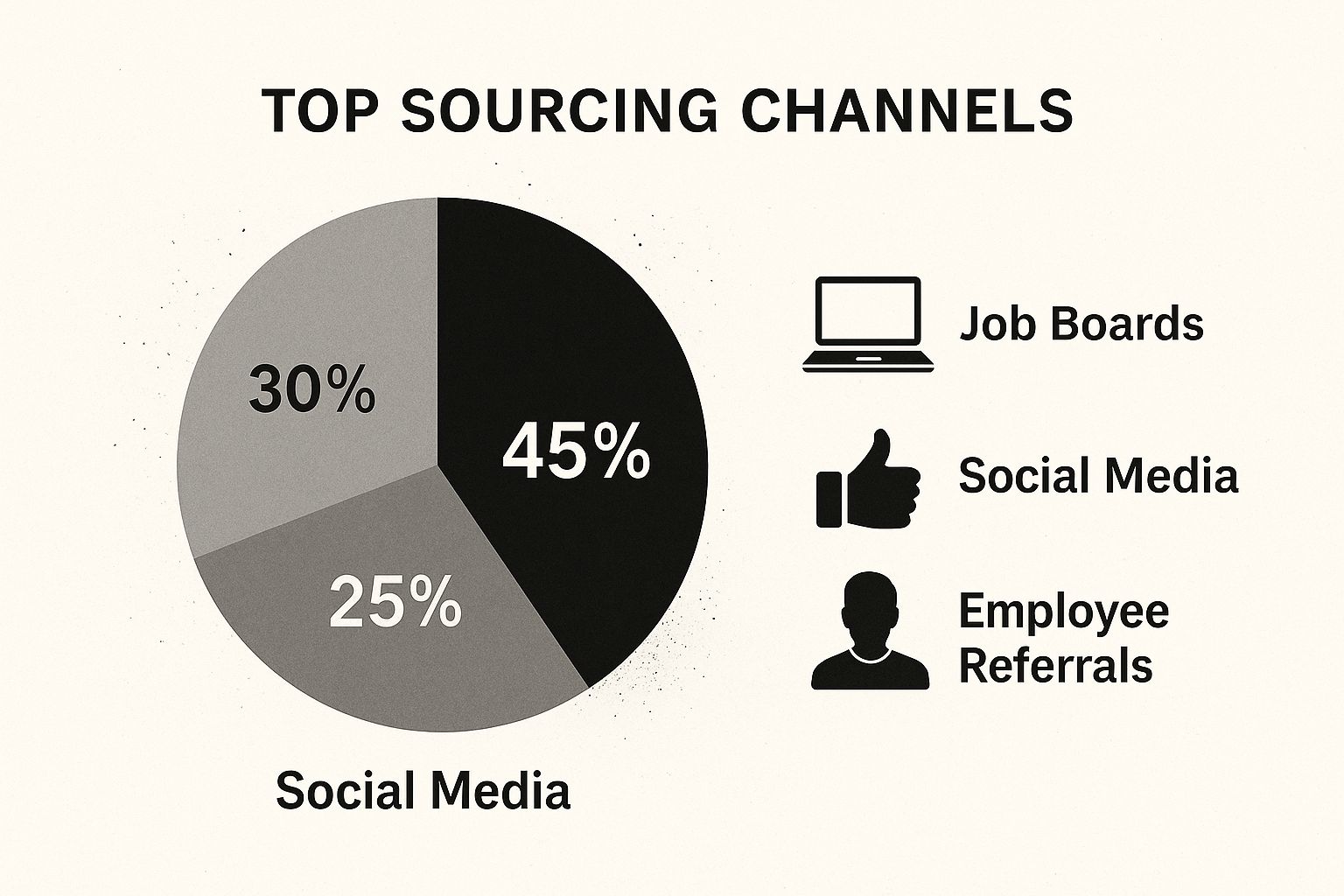July 31, 2025
How to Improve Recruitment Process: Top Strategies to Attract Talent

If you want to get serious about improving your recruitment, you have to stop treating it like a series of disconnected tasks. It's time to move beyond the old "post and pray" method and build a proactive, unified system that works for you. This means creating a modern framework that focuses on four key areas: strategic sourcing, smart screening, human-focused interviews, and a smooth onboarding process. When you get these right, hiring stops being a chaotic scramble and becomes a predictable, high-performing part of your business.
Building Your Modern Recruitment Framework

Too many companies fall into the same trap. A position opens up, and it's all hands on deck in a frantic search to fill the seat. This reactive approach is not only inefficient, but it also almost guarantees you'll settle for a "good enough" candidate instead of finding someone who can truly elevate your team.
A modern recruitment framework is built on foresight and strategy. It's about turning talent acquisition from a back-office chore into a real competitive advantage. This means you’re not just filling roles as they appear; you're building a continuous pipeline of great people and nurturing relationships long before you even have a job opening. The goal is to make your company a place where the best people want to work.
The Four Pillars of an Improved Recruitment Process
To get there, you need to master four interconnected stages of the hiring journey. Think of them as pillars supporting your entire recruitment structure. If one is weak, the whole thing can come crashing down. These pillars represent the core areas where you can make the most significant impact.
The table below breaks down these four essential areas, their primary goals, and the key action you need to take for each.
By focusing your efforts on these four pillars, you create a holistic system that attracts, identifies, and retains top performers. It's a fundamental shift in thinking.
The most significant change you can make is to stop hiring for today’s emergency and start building relationships for tomorrow’s needs. This proactive mindset is the cornerstone of every successful recruitment strategy.
This strategic evolution isn't just a good idea; it's backed by major industry trends. Over the last five years, budgets for employer branding have shot up by 107%, and 85% of talent leaders say diversity hiring is a top priority. This shows a clear market-wide focus on building attractive, inclusive workplaces.
At the same time, the projected 18.5% annual growth in recruitment process outsourcing (RPO) points to a global demand for more specialized and efficient hiring strategies. For a deeper dive into these trends, you can explore more insights about global recruitment shifts on Talentmsh.com.
Getting Ahead of the Game with Proactive Sourcing

If you're only recruiting when you have an open role, you're already behind. The best way to elevate your hiring process is to stop being reactive and start sourcing proactively. Instead of scrambling when a key team member gives their notice, you should already have a pipeline of great people who know who you are. This simple shift turns the panic of a sudden vacancy into a calm, strategic search.
The cornerstone of great sourcing is knowing exactly who you're looking for. I'm not talking about a bulleted list of skills on a job description. I'm talking about a deep, detailed ideal candidate persona. Think about their motivations, career goals, and even how they prefer to be contacted.
For instance, a persona for a Senior DevOps Engineer might reveal they value remote work flexibility, hang out at specific tech meetups, and only respond to outreach that gets straight to the point about complex technical challenges. Armed with that knowledge, your sourcing becomes infinitely more effective.
How to Build Your Talent Pools
Once your persona is crystal clear, you can go find where these people are. Don't just post on a job board and hope for the best. You need to focus your energy on the platforms and communities where passive candidates—talented folks who are employed but open to a great opportunity—spend their time.
- Mastering LinkedIn: Go way beyond just sending connection requests. Use advanced search filters to zero in on professionals who fit your persona. When you reach out, make it personal. Reference a specific project on their profile or a mutual connection. A generic, copy-pasted message is a one-way ticket to being ignored, but a thoughtful note can start a real conversation.
- Finding Niche Communities: Where do your ideal candidates go to learn and share ideas? Look for specialized Slack channels, online forums, or industry-specific groups. Become an authentic participant, not just a recruiter lurking in the background. This builds credibility and gives you a direct line to genuine experts.
- Leveraging Employee Referrals: Your current team is one of your best-kept sourcing secrets. A solid employee referral program can slash your time-to-hire. Offer incentives that actually matter and, most importantly, make the referral process incredibly simple for your team.
The hiring market today is no joke. The competition for top talent is fierce. Recent data reveals that 42% of companies say increased talent competition is making hiring harder, and 41% know they need to expand their talent pipelines to keep up. According to industry analysis, building stronger candidate relationships and improving communication are the top priorities for talent leaders trying to keep people from dropping out of their process. You can dig deeper into these recruiting challenges and statistics on SelectSoftwareReviews.com.
Proactive sourcing is a lot like investing. You put in consistent effort over time to build relationships and grow your network. When you need to make a "withdrawal"—or hire someone—the resources are already there waiting for you.
This isn't a quick fix; it's a long-term strategy that requires patience. But the payoff is huge. It transforms recruiting from a frantic, transactional chore into a continuous, relationship-driven part of your business. By building these talent pools, you ensure that when a role finally opens up, you’re not starting from zero. You’re simply activating a warm network of pre-vetted, high-quality people who are already familiar with your brand.
Screening: Where Good Hiring Gets Stuck (And How to Fix It)
If there's one place the hiring process grinds to a halt, it's screening. It’s an absolute avalanche of resumes. Your team is buried, trying to find the hidden gems while your top candidates are getting snapped up by competitors who move faster.
This is where you have to get smart. Moving past a purely manual review isn't just a "nice to have" anymore; it's essential for building a faster, more equitable hiring system.
An Applicant Tracking System (ATS) is your first line of defense, creating a central hub for applications and communication. It brings some order to the chaos. But let's be honest, an ATS by itself doesn't solve the core problems: the sheer volume of applicants and the unconscious bias that creeps into every manual review. That’s where the real game-changers come in.
From Keywords to Real-World Skills
The big shift happens when you start looking beyond the resume. Keyword-matching is an old, flawed system. It often filters out fantastic candidates who just didn't use the "right" jargon or whose experience is non-traditional but highly relevant.
This is where AI-powered assessment platforms like Klearskill completely change the dynamic. Instead of just scanning for keywords, these tools can analyze a candidate's work or test results against the actual skills you need for the job. They provide objective, data-backed scores on everything from technical abilities to core competencies.
Essentially, you stop focusing on pedigree and start focusing on capability.
Take a look at how a tool like Klearskill visualizes the candidate pipeline. This kind of Kanban-style board makes it immediately clear where everyone stands, so nobody gets lost in a spreadsheet or an overflowing inbox.

The numbers paint a pretty stark picture. For any given role, you might get 74 applicants, but only 4.3% of them will ever make it to an interview. That massive drop-off tells you how critical it is to have a system that can spot top talent quickly and accurately. In fact, AI-assisted recruiting can slash time-to-hire by 26%—a huge win. And in high-demand fields like tech, where a single job can attract 110 applicants, speed is everything.
You can dig deeper into these trends by checking out this 2025 report on winning the talent race.
The data below shows how different hiring channels perform. While job boards cast a wide net, don't underestimate the power of your internal network.

Blending Automation with the Human Touch
Look, bringing in technology isn't about firing your recruiters. It's about freeing them up to do the work that actually matters: connecting with people. When you automate the repetitive, high-volume parts of screening, your team suddenly has the time to build real relationships with your most promising candidates.
To see just how big of an impact this shift can have, let's compare the old way with a more modern, tech-assisted approach.
Manual Screening vs AI-Assisted Screening
The difference is clear. AI doesn't replace recruiters; it makes them more strategic, efficient, and fair.
The real goal of technology in screening isn't to replace human judgment—it's to sharpen it. Let the tools handle the "what" (skills, qualifications) so your team can focus on the "who" (motivation, culture fit, and potential).
Here’s how you can strike that perfect balance:
- Automate the Absolutes: Use your ATS and AI tools to instantly filter for the non-negotiables. Think certifications, work authorization, or specific, must-have technical skills.
- Assess for Ability: For your shortlisted group, deploy skills-based assessments. This gives you an objective look at what they can do before you even schedule the first call.
- Engage with Intention: Once technology has surfaced the true top contenders, your recruiters can step in to have the deep, meaningful conversations that interviews are supposed to be about.
This isn't just about filling roles faster. It's about making smarter, data-backed decisions that reduce bias and ultimately lead to hires who stick around and thrive.
Conducting Interviews That Predict Performance
Let's be honest: most interviews are broken. They often devolve into unstructured chats that tell you more about the interviewer's biases than a candidate's ability to actually do the job. If you want to make a real impact on your hiring, you have to move beyond generic Q&As and start conducting structured interviews that are actually designed to predict on-the-job success.
The secret sauce to a predictive interview is consistency. It’s that simple. This means every single candidate for a specific role gets asked the same core set of job-related questions, in roughly the same order. This gives you a solid baseline for comparison, making your evaluations far more objective and fair. You’re no longer asking, "Did I like them?" but rather, "Did they show me they have the skills we need?"
Designing Questions That Reveal True Capability
The best interviews feel less like an interrogation and more like a deep dive into a candidate's real-world experience. The goal is to ask questions that compel people to demonstrate their skills, not just talk about them in the abstract. You want evidence, not just assertions.
I’ve found two types of questions are incredibly powerful for getting past the fluff:
- Behavioral Questions: These are your "tell me about a time when..." questions. Instead of asking something generic like, "Are you a team player?" you get specific. Try this: "Tell me about a time you had a significant disagreement with a colleague on a project. What was the situation, and what was your specific role in resolving it?" This forces them to share a real story, revealing their actual approach to conflict.
- Situational Questions: These are forward-looking and present a realistic, job-related scenario. For a customer support role, you might ask, "A high-value client is furious because their shipment is late, and it's entirely our fault. Walk me through how you'd handle that call, step by step."
These types of questions peel back the layers of rehearsed answers. They show you how a candidate genuinely thinks on their feet, solves problems, and behaves under the kind of pressure they’d actually face in the role.
Training Your Interviewers to Be Better
Your interview process is only as strong as your least-trained interviewer. When hiring managers are left to their own devices, they often fall back on "gut feeling"—a polite term for bias. This leads to inconsistent, unfair, and often poor hiring decisions. Equipping them with the right training and tools is non-negotiable.
This training needs to be practical. Show them how to stick to the structured questions, what to listen for in an answer, and—critically—how to spot and avoid common pitfalls like the "halo effect," where one great answer makes them overlook red flags elsewhere. A simple scoring rubric for each question can work wonders in keeping evaluations objective.
An interview should be a respectful, two-way discovery process. Yet, a startling 83% of candidates say they've had a bad experience during the hiring process. Simply by ensuring your interviewers are well-trained and empathetic, you create a standout positive impression, whether you make an offer or not.
Panel interviews can also be a game-changer when done right. Bringing different stakeholders into the room—think a future peer, a cross-functional partner, and the hiring manager—gives you a much richer, 360-degree view of the candidate. The key is to assign specific areas for each panelist to probe before the interview and have a structured debrief to combine their feedback afterward. This collective intelligence is what leads to confident, well-rounded hiring decisions.
Closing the Deal with Strong Offers and Onboarding

You’ve sourced, screened, and interviewed, and you've finally found the one. It feels like the race is over, but this last lap is where you can either win big or lose everything. The offer and onboarding are your final, critical moments to secure that top-tier talent and set them up for a successful future with your company.
A lackluster offer or a chaotic first week can unravel all your hard work in an instant. Suddenly, that star candidate you courted for weeks is accepting a counteroffer from a competitor. If you want to truly improve your recruitment process, you need to give this final stage the same strategic attention you gave to sourcing.
Crafting an Offer They Can't Refuse
Look, great offers are about so much more than the salary. Compensation is a huge piece of the puzzle, of course, but the best candidates are evaluating the entire picture. They're looking for a future, not just a paycheck, and want to feel like they're making a smart career move.
Don't just shoot over an email with a number in it. That's a rookie mistake. Get them on the phone and walk them through the entire package. This is your chance to really sell the role and the company one last time.
- Show them the path forward: What does growth look like? Talk about specific training opportunities, mentorship programs, or how others in similar roles have advanced.
- Highlight the unique perks: Go beyond the standard health insurance. Do you have a killer wellness stipend, genuinely flexible hours, or a generous PTO policy? Now's the time to brag a little.
- Bring it back to the "why": Remind them of what got them excited during the interviews—the team they clicked with, the mission they believe in, the problems they'll get to solve.
This personal touch shows you’re invested in them as an individual, not just a headcount. It also gives you a real-time pulse check on their reaction and prepares you for any negotiations or the dreaded counteroffer from their current job.
The moment you extend an offer is your last, best chance to sell the opportunity. Frame it as the beginning of a partnership, highlighting mutual growth and success, not just a transactional exchange of work for pay.
Building an Onboarding Experience That Retains Talent
The onboarding clock starts ticking the second they say "yes." A structured, welcoming experience is one of the most powerful tools you have against early turnover. I've seen it happen time and again: a new hire gets thrown into the deep end with no plan, and within a month, they're already looking for the exit.
A great onboarding program is a well-oiled machine. It’s designed to make a new person feel supported, prepared, and productive from their very first day. It has to cover both the practical stuff (like getting their laptop) and the cultural immersion (like understanding the unwritten rules).
For example, a solid plan always includes:
- Pre-start communication: A simple "we're so excited for you to join!" email from the team a week before they start goes a long way.
- Day-one readiness: Their laptop, logins, and key software access should be set up before they walk through the door. No exceptions.
- A 30-60-90 day plan: Give them a clear roadmap. What should they learn, who should they meet, and what should they accomplish in their first three months?
- An onboarding buddy: Pair them with a peer—not their manager—who can show them the ropes, answer the "silly" questions, and help them navigate the social side of the office.
This level of preparation sends a powerful signal: you're organized, you're professional, and you're genuinely invested in their success. It turns the anxiety of starting a new job into excitement, setting the stage for a long, happy career at your company.
Using Data to Continuously Improve Your Process
Improving your hiring process isn't a one-and-done project; it’s a constant cycle of refining what works and ditching what doesn't. All the strategies we've discussed are fantastic, but you unlock their real power only when you start measuring your results. Without data, you’re just flying blind.
A data-driven approach moves recruiting from a reactive, fire-fighting function to a strategic one. It lets you find weaknesses with near-surgical precision and make decisions you can actually stand behind with confidence. You’ll go from a vague feeling that things are slow to knowing exactly where the bottlenecks are.
Identifying Your Most Important KPIs
To get started, you need to track a handful of key performance indicators (KPIs). Think of these as the vital signs of your recruiting health. There's no need to overcomplicate things—just focus on the numbers that give you the clearest picture.
Here are the essentials:
- Time-to-Fill: This is the total number of days from when a job requisition is approved to when a candidate accepts the offer. If this number is climbing, it could point to a sluggish screening process or delays in the interview rounds.
- Cost-per-Hire: This is the total sum of your recruiting expenses (think job board fees, ad spend, even your team's time) divided by the number of people you hired. This metric is your best friend when you need to justify investing in new tools or programs.
- Source-of-Hire: This one is simple but powerful: where do your best hires actually come from? Is it employee referrals, LinkedIn, specific job boards, or your own career page? This tells you exactly where to put your sourcing budget for the best return.
- Quality-of-Hire: This is the ultimate yardstick for success. It’s a bit trickier to measure but often involves looking at new hire performance reviews, retention rates after 6-12 months, and hiring manager satisfaction surveys. It answers the most critical question: are we hiring people who truly excel here?
Turning Data into Actionable Improvements
Just collecting data isn't enough. The real magic happens when you analyze those numbers to spot opportunities. If you know how to listen, the data will tell you a story.
Let's say you notice a high number of candidates are dropping out of the process right after the first interview. That’s a huge red flag. It’s a clear signal to dig into your interview experience. Are your interviewers properly trained? Are the questions you're asking relevant to the job, or are they just brain teasers? Is the whole experience just clunky and off-putting for candidates?
Data gives you the power to stop asking "what's wrong?" and start pinpointing exactly where to focus your energy. It turns vague problems into specific, solvable challenges.
By consistently tracking these metrics, you create a powerful feedback loop that fuels constant improvement. This approach doesn't just help you fill roles faster; it builds a more efficient, fair, and strategic recruiting engine that becomes a genuine asset to the entire organization.
Common Questions About Improving Recruitment
As you start to fine-tune your hiring process, a few key questions almost always surface. Getting straight, practical answers to these is the best way to move forward with confidence and sidestep some common hurdles.
How Can Small Businesses Improve Recruitment on a Tight Budget?
When you’re working with a lean budget, you have to focus on what gives you the most bang for your buck. Your best, and often cheapest, starting point is an employee referral program. It’s a powerful way to tap into networks you already trust.
Beyond that, really invest some time in your employer brand on free platforms like LinkedIn. You don't need a massive budget to share your company's culture, highlight team successes, and show people what it's really like to work with you. Finally, nail the candidate experience. Clear, consistent communication costs nothing, but it makes all the difference in whether top talent sees you as a professional, desirable place to work.
What Is the Most Important Metric for Recruitment Success?
While everyone watches time-to-hire and cost-per-hire, the metric that truly matters in the long run is Quality of Hire.
This isn't just about filling a seat quickly. Quality of Hire measures the actual value a new employee adds to your company over time. You can track it through things like performance reviews, how long they stay with the company, and feedback from their managers. It tells you if your hiring process is actually predicting on-the-job success.
A focus on Quality of Hire forces you to ask the right questions: Are we identifying the right skills? Is our interview process predictive? Does our onboarding set people up to succeed? This metric aligns your hiring efforts with real business outcomes.
How Can We Reduce Bias Without Slowing Down?
This is a big one, but you can build a fairer process without grinding everything to a halt. The key is structure.
Start by implementing structured interviews, where every candidate for a role gets the same core, job-related questions. This creates a much more reliable baseline for comparison. You can also use blind screening techniques—simply removing names and other identifying details from resumes during the initial review. And this is where technology can be a huge help; AI-powered tools can add an objective layer by assessing skills, ensuring you’re judging capability, not just a resume or a gut feeling.
Ready to make your screening faster and fairer? Klearskill uses AI to analyze resumes, score candidates on real skills, and eliminate bias. See how you can reduce screening time by 92% and ensure you’re focusing on the best-fit talent. Start hiring smarter today.
